Fungus gnats are insects commonly associated with houseplants. They are small, about the size of a fruit fly, and black. Adults are most commonly seen running across the soil surface. They do not bite and represent no threat to human health. Although adults are weak fliers, when large numbers of gnats are present they may fly from plant to plant or throughout a room, becoming a nuisance.

Adult females lay 75 to 200 eggs, which hatch in a week, in cracks in the potting mix surface. The larvae, called maggots, feed on soil fungi, organic matter in the potting mix and on plant roots. Feeding on plant roots may injure houseplants or allow root-rotting fungi to enter. After sufficient feeding, maggots pupate and become adults. The entire life cycle takes about five weeks, but adults only live about five days.
High moisture levels encourage fungus gnats, as do potting mixes with high levels of organic matter. Use potting mixes which drain well, and avoid over watering. Allowing soils to dry somewhat between waterings will reduce fungus gnat problems, as larvae are very susceptible to drying out.
Yellow sticky traps suspended above houseplants may capture several adults, or careful use of a houseplant insecticide containing resmethrin can control adult gnats.
Larvae can be captured before maturation by placing a half-inch thick slice of potato on the soil surface. Shiny white, worm-like larvae with a dark head can later be found on the soil surface or adhering to the potato slice, which can then be discarded. Products containing a specific strain of “Bt,” a biological insecticide, applied to the soil kills larvae. However, these are not widely available and some are marketed only to
large-scale greenhouse operations.
For more information, see the following Colorado State University Extension fact sheet(s).



